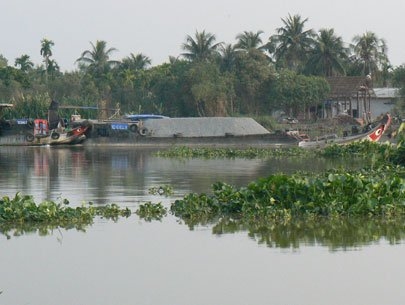The Saigon River has become more and more seriously polluted due to the increasingly high volume of untreated water discharged to the river every day. Meanwhile, both competent agencies and scientists are still fumbling for an effective solution to control the polluted river.
Pollution increases rapidly, solutions come late

Ho Chi Minh City every day discharges more than one million cubic metres of domestic waste water to Saigon River, while Binh Duong province discharges 41,500 cubic metres of urban waste water and nearly 40,000 cubic metres of industrial waste water.
Meanwhile, according to Le Viet Thang, MA, from the Water and Environment Technology Institute, less than 20 percent of the waste water is treated before flowing to the valleys of the Saigon River.
Tran Van Quang, Deputy Head of the Binh Duong provincial Environment Protection Sub-department, admitted that it is very difficult to control the waste water of industrial workshops in the province, and that many enterprises keep discharging untreated waste water to the environment.
“There are over 5000 industrial production enterprises, while only 20 percent of waste water is treated in accordance with the required standards,” Quang said.
The Binh Duong provincial authorities have installed an automatic waste water monitoring mechanism at six industrial zones in the province, which clearly shows that treated waste water still cannot meet the required standards. Quang said that the provincial authorities plan to install cameras as well to observe the waste water discharge.
Phung Chi Sy, Deputy Head of the Institute for Tropical Technology and Environmental Protection, has pointed out that no proper solution to ease the Saigon River’s pollution has been found because of the unreasonable management mechanism.
“We have too many projects and too many sub-committees, which has made it unable to cooperate and connect the sub-committees,” Sy said.
He cited the story about Ba Bo canal as an example to show that it is very difficult for local authorities to cooperate and join forces to settle problems.
Therefore, scientists have suggested that separated plans should be drawn up for different localities, including Ho Chi Minh City, Binh Duong and Tay Ninh. The plans should clearly stipulate which locality needs to do what things. After that, the implementation of the plans will be put under the coordinating of a sub-committee on protecting Saigon River.
Vietnam to learn US’ pollution management mechanism
According to Lam Minh Triet, experts have suggested to apply WPA (Watershed Protection Approach) of the US Environmental Protection Agency (EPA) in managing the pollution of Saigon River.
WPA is a model of managing river water which includes six steps: monitoring, appraising, defining priority goals, developing management strategies, drawing up management plan and implementing.
“This is for the first time we use the model. The model can be applied to other river valleys in Vietnam,” Triet said.
“We have to do everything we can to save the Saigon River,” Triet said.
Also according to Triet, there are 13 projects which experts say need to be implemented right in the period of 2011-2015, with the total cost of VND17 trillion (USD825.24 million) to help ease the pollution of the Saigon River.
Local authorities of the three provinces and cities on the valleys of Saigon River will sit together to find a consensus about what to do to ease the pollution. “It is very likely that a sub-committee of Saigon River Valley will be established,” Triet said.

Leave your comment on this story